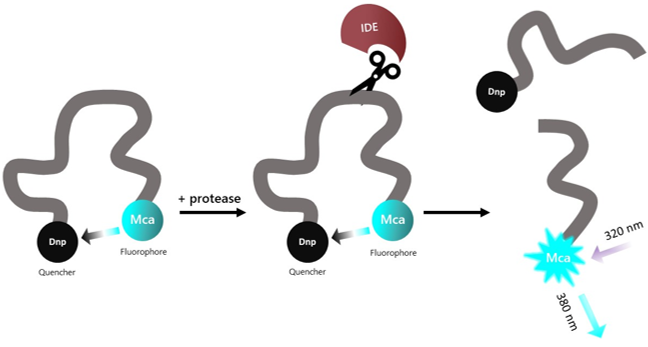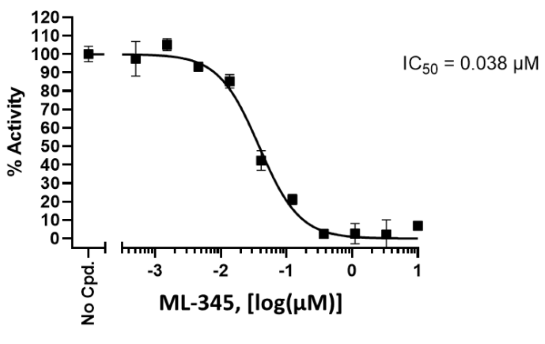IDE Inhibitor Screening Assay Kit
The IDE (Insulin-degrading enzyme) Inhibitor Screening Assay is a homogeneous fluorogenic assay designed to measure the activity of IDE for screening and profiling applications. The IDE assay kit comes in a convenient 96-well or 384-well format and contains enough purified IDE (amino acids 71-254), substrate, and PR-02 buffer for 100 or 400 reactions.

Figure 1: Illustration of the assay principle.
The substrate is an internally quenched fluorogenic substrate. Proteolysis releases the highly fluorescent Mca from the quencher. Fluorescence intensity increases proportionally to the activity of the protease.
Need us to run inhibitor screens or profile your compounds against IDE? Check out our Protease Screening Services.
96 reactions
| Catalog # | Name | Amount | Storage |
| 70002 | IDE, His-Tag* | >1 µg | -80°C |
| PR Substrate 1 | 5 µl | -80°C | |
| PR-02 Buffer | 10 ml | -20°C | |
| 79685 | 96-well black microplate | 1 | Room Temp |
* The concentration of protein is lot-specific and will be indicated on the tube containing the protein.
384 reactions
| Catalog # | Name | Amount | Storage |
| 70002 | IDE, His-Tag* | >2 µg | -80°C |
| PR Substrate 1 | 2 x 5 µl | -80°C | |
| PR-02 Buffer | 2 x 10 ml | -20°C | |
| 79961 | 384-well black microplate | 1 | Room Temp |
* The concentration of protein is lot-specific and will be indicated on the tube containing the protein.
IDE (Insulin-degrading enzyme) is a zinc metallopeptidase with a ubiquitous pattern of expression in humans. Although initially identified as an insulin degrading protein, it can also interact with glucagon, somatostatin, β-amyloid and natriuretic peptide. IDE is involved in multiple pathways, such as Varicella Zoster Virus infection, steroid receptor signaling and proteasomal modulation of insulin. More recently IDE was identified as a heat-shock like protein capable of processing antigenic peptides presented by MHC class I. Dysregulation of IDE may be involved in Alzheimer’s disease, Type 2 Diabetes Mellitus, and it may play a role in neuroblastoma growth. The identification of IDE inhibitors is crucial for the understanding of IDE role in disease and potential therapeutical approaches.



